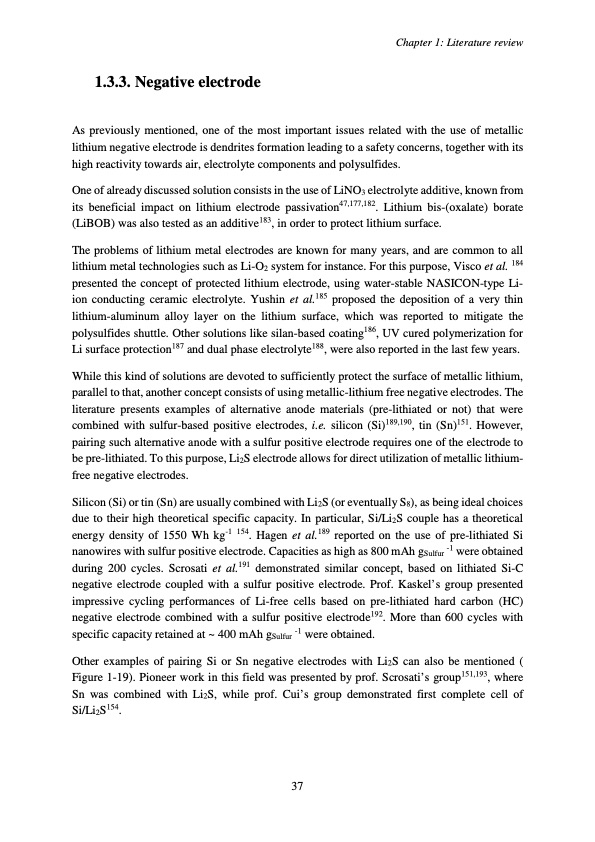
PDF Publication Title:
Text from PDF Page: 041
1.3.3. Negative electrode As previously mentioned, one of the most important issues related with the use of metallic lithium negative electrode is dendrites formation leading to a safety concerns, together with its high reactivity towards air, electrolyte components and polysulfides. One of already discussed solution consists in the use of LiNO3 electrolyte additive, known from its beneficial impact on lithium electrode passivation47,177,182. Lithium bis-(oxalate) borate (LiBOB) was also tested as an additive183, in order to protect lithium surface. The problems of lithium metal electrodes are known for many years, and are common to all lithium metal technologies such as Li-O2 system for instance. For this purpose, Visco et al. 184 presented the concept of protected lithium electrode, using water-stable NASICON-type Li- ion conducting ceramic electrolyte. Yushin et al.185 proposed the deposition of a very thin lithium-aluminum alloy layer on the lithium surface, which was reported to mitigate the polysulfides shuttle. Other solutions like silan-based coating186, UV cured polymerization for Li surface protection187 and dual phase electrolyte188, were also reported in the last few years. While this kind of solutions are devoted to sufficiently protect the surface of metallic lithium, parallel to that, another concept consists of using metallic-lithium free negative electrodes. The literature presents examples of alternative anode materials (pre-lithiated or not) that were combined with sulfur-based positive electrodes, i.e. silicon (Si)189,190, tin (Sn)151. However, pairing such alternative anode with a sulfur positive electrode requires one of the electrode to be pre-lithiated. To this purpose, Li2S electrode allows for direct utilization of metallic lithium- free negative electrodes. Silicon (Si) or tin (Sn) are usually combined with Li2S (or eventually S8), as being ideal choices due to their high theoretical specific capacity. In particular, Si/Li2S couple has a theoretical energy density of 1550 Wh kg-1 154. Hagen et al.189 reported on the use of pre-lithiated Si nanowires with sulfur positive electrode. Capacities as high as 800 mAh gSulfur -1 were obtained during 200 cycles. Scrosati et al.191 demonstrated similar concept, based on lithiated Si-C negative electrode coupled with a sulfur positive electrode. Prof. Kaskel’s group presented impressive cycling performances of Li-free cells based on pre-lithiated hard carbon (HC) negative electrode combined with a sulfur positive electrode192. More than 600 cycles with specific capacity retained at ~ 400 mAh gSulfur -1 were obtained. Other examples of pairing Si or Sn negative electrodes with Li2S can also be mentioned ( Figure 1-19). Pioneer work in this field was presented by prof. Scrosati’s group151,193, where Sn was combined with Li2S, while prof. Cui’s group demonstrated first complete cell of Si/Li2S154. 37 Chapter 1: Literature reviewPDF Image | Accumulateur Lithium Soufre

PDF Search Title:
Accumulateur Lithium SoufreOriginal File Name Searched:
WALUS_2015_archivage.pdfDIY PDF Search: Google It | Yahoo | Bing
Sulfur Deposition on Carbon Nanofibers using Supercritical CO2 Sulfur Deposition on Carbon Nanofibers using Supercritical CO2. Gamma sulfur also known as mother of pearl sulfur and nacreous sulfur... More Info
CO2 Organic Rankine Cycle Experimenter Platform The supercritical CO2 phase change system is both a heat pump and organic rankine cycle which can be used for those purposes and as a supercritical extractor for advanced subcritical and supercritical extraction technology. Uses include producing nanoparticles, precious metal CO2 extraction, lithium battery recycling, and other applications... More Info
| CONTACT TEL: 608-238-6001 Email: greg@infinityturbine.com | RSS | AMP |